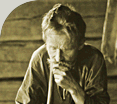 |
| Main page | Background | Villages | Revitalisation | Cultural tourism | Map | |
Akonlahti |
Akonlahti Ugly fate of Akonlahti What to see |
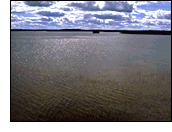 The
villages on the shores of Lake Kiitehenjärvi have played a crucial
role in both the creation of the Kalevala and the rise of Karelianism.
No other bardic village has attracted as many poetry collectors, culture
researchers, and artists inspired by Karelianism as Akonlahti. The
village was also the first place where Lönnrot came into contact with
Viena and its poetic treasures. The
villages on the shores of Lake Kiitehenjärvi have played a crucial
role in both the creation of the Kalevala and the rise of Karelianism.
No other bardic village has attracted as many poetry collectors, culture
researchers, and artists inspired by Karelianism as Akonlahti. The
village was also the first place where Lönnrot came into contact with
Viena and its poetic treasures.
Akonlahti includes the main village, as well as several nearby groups of villages: Munankilahti, Sappovaara, Tetriniemi, Märkävaara and Jehrimänvaara. At their largest, the villages have comprised a total of 90 houses with some 600 inhabitants. Until the border between Finland and Russia was closed, the villages of Akonlahti had regular and frequent contact with the adjacent Finnish village of Rimpi in Kuhmo. Lönnrot did not reach Viena until his third field trip, in 1832.
Viena, and Akonlahti in particular, had long been his goal, and
his visit was not a disappointment. Collectors Lönnrot himself visited Akonlahti a second time (1833) before other collectors set their sights on the village. But then they came in large numbers. At least the following collectors are known to have visited Akonlahti: J.F Cajan (1836), M.A. Castrén (1839), D.E.D. Europaeus (1845), Arvid Genetz (1871), A.A. Borenius (1871), Aksel Berner (1872), P.J. Hannikainen (1877), A. W. Ervasti (1879), Hj. Basilier (1879), Matti Varonen (1886), J.W. Juvelius (1886), Heiki Meriläinen (numerous field trips in the 1880s), Lauri Pääkkönen (1892), K.F. Karjalainen (1894), A.R. Niemi (1904), F. Ohrt (1906), R. Engelberg (1909), Samuli Paulaharju (1915) and Väinö Kaukonen (1943). The list is impressive, but so was the body of poetry these collectors recorded. Bards On his first field trip to Akonlahti, Lönnrot recorded the following
poems sung by Soava Trohkimainen In autumn of 1839, Lönnrot visited Akonlahti on a work-related
trip and obtained 23 poems totalling 350 lines. In the same year
Castrén reported recording almost 40 spells from a single The Karelianists Akonlahti was the first destination of Karelianists Akseli Gallen-Kallela and Louis Sparre when they set off across the border in search of the song-lands of the Kalevala. Both artists made many drawings and sketches of the village and its people, and these images are reflected in their other works. In the summer of 1890, they made two separate trips to Akonlahti. Two years later, Sparre came to Akonlahti again on his second Viena pilgrimage, accompanied this time by the sculptor Emil Wikström. Sparre told of this journey in his book "A Visit with the People of the Kalevala", which includes numerous sketches of the villages along Lake Kiitehenjärvi and the people in them. In 1894, two significant teams of enthusiasts visited Akonlahti:
I.K. Inha and Kusti Karjalainen, and Yrjö Blomstedt and Viktor Sucksdorff.
Inha's and Karjalainen's trip yielded the greatest accomplishment
of Karelianism: Inha's series of photographs has done more to shape
Finns' Blomstedt and Sucksdorff were architects who meticulously documented the Karelian building tradition and later published their work as a book which significantly influenced the rise of the National Romantic School in Finnish architecture. The villages of Akonlahti were the only places in Viena besides Luvajärvi that Blomstedt and Sucksdorff visited on their trip, as they continued on from there to North Aunus. |
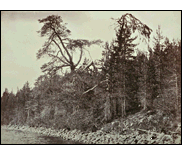 At the end of his account of the trip, Lönnrot encouraged other
poetry collectors to look for old folk poems in the area, stating
that anyone who went there "would be richly rewarded for his efforts".
At the end of his account of the trip, Lönnrot encouraged other
poetry collectors to look for old folk poems in the area, stating
that anyone who went there "would be richly rewarded for his efforts".
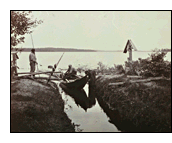 :
the Sampo Episode, The Rivals, Hunting the Elk of Hiisi, Sister's
Ruin, or The Children of Tuiretuinen, Forging a Bride of Gold, Lemminkäinen's
Tale, as well as a number of spells. Soava's poems were significant
elements in the creation of the first edition of the Kalevala. Lönnrot
did not include The Sister's Ruin, or The Children of Tuiretuinen,
in the first edition of the epic but he did publish it in the Kanteletar.
He adapted the poem and included it in the second edition as part
of the Kullervo Cycle, making use of variants he had obtained elsewhere.
:
the Sampo Episode, The Rivals, Hunting the Elk of Hiisi, Sister's
Ruin, or The Children of Tuiretuinen, Forging a Bride of Gold, Lemminkäinen's
Tale, as well as a number of spells. Soava's poems were significant
elements in the creation of the first edition of the Kalevala. Lönnrot
did not include The Sister's Ruin, or The Children of Tuiretuinen,
in the first edition of the epic but he did publish it in the Kanteletar.
He adapted the poem and included it in the second edition as part
of the Kullervo Cycle, making use of variants he had obtained elsewhere.
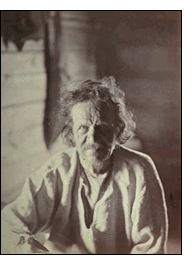 bard
in the village.
bard
in the village.
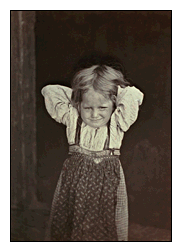 images
of the song-lands of the Kalevala than any other, and his accounts
of his journeys, which soon became classics, have brought the culture
of Viena to generation after generation of Finnish readers in superb
detail. Inha took a substantial number of photographs in the area
around Lake Kiitehenjärvi.
images
of the song-lands of the Kalevala than any other, and his accounts
of his journeys, which soon became classics, have brought the culture
of Viena to generation after generation of Finnish readers in superb
detail. Inha took a substantial number of photographs in the area
around Lake Kiitehenjärvi.